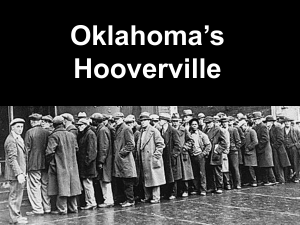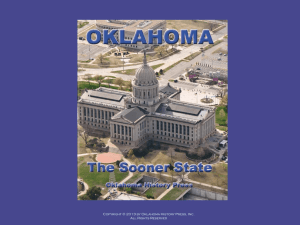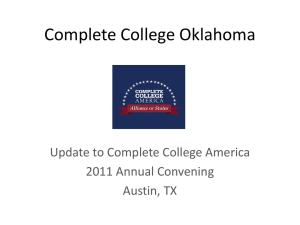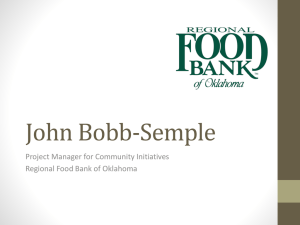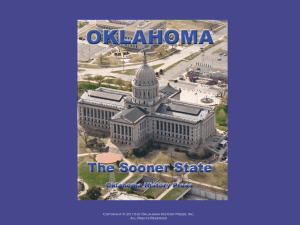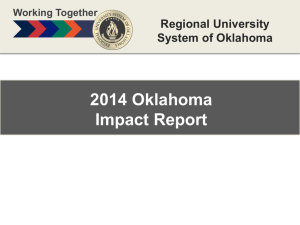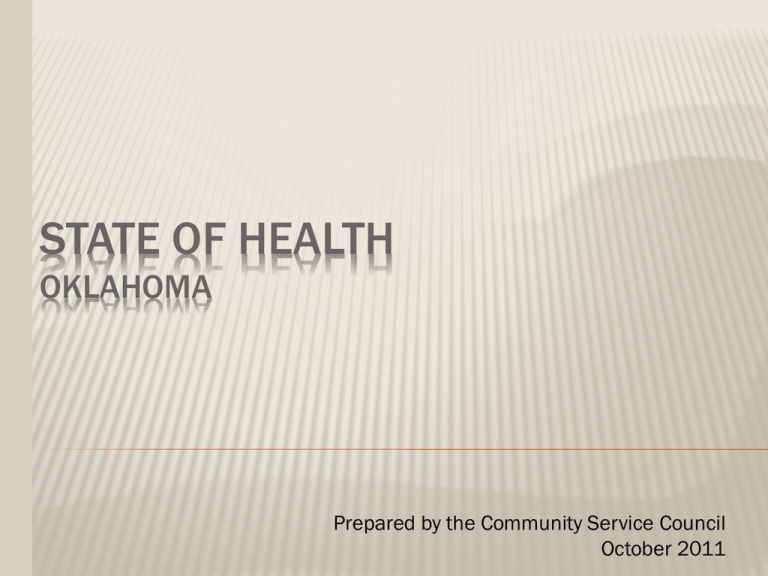
STATE OF HEALTH
OKLAHOMA
Prepared by the Community Service Council
October 2011
OKLAHOMA
Demographic Trends
Economics and Employment
Health Indicators Indicators
DEMOGRAPHIC TRENDS
DEMOGRAPHIC TRENDS
Population change--migration to suburban
areas of Tulsa and Oklahoma City MSA with
an overall decrease in new births
Age--aging population
Race and ethnicity--more culturally diverse
Living arrangements--transitional for family
living arrangement
Population Trends for Total Population and Under Age 5
Oklahoma, 1980 through 2030
5,000,000
4,000,000
3,000,000
2,000,000
1,000,000
0
Total Population
Under age 5
1980
1990
2000
2010
2020
(proj.)
2030
(proj.)
3,025,290
3,145,585
3,450,654
3,751,351
3,735,690
3,913,251
233,307
226,523
236,353
264,126
255,652
277,000
Source: US Census Bureau, 1980, 1990, 2000, and 2010 Censuses; Population Estimates Program.
Prepared by the Community Service Council of Greater Tulsa
Race Comparison for Total Population and Children under 5
Oklahoma, 2010
Under 5
Total Population
10.1%
59.3%
1.7%
19.8%
8.6%
72.2%
7.4%
1.6%
11.0%
8.2%
Hispanic
16.8%
Hispanic
8.9%
N = 264,126
White
Black
American Indian
Asian
N = 3,751,351
Other/2+ races
Source: US Census Bureau, 2010 Census.
Prepared by the Community Service Council of Greater Tulsa
Population Trends and Projections by Age Group
P ro je ctio n s
Oklahoma, 1970 - 2030
2030
7.1
17.9
9.6
46
2020
6.8
18.2
9.2
49.1
2010
7
17.7
10.2
2000
6.8
19
1990
7.2
19.4
1980
7.7
1970
7.7
0%
20.5
1.7
10.3
50.6
11.6
1.7
10.2
49.7
12
1.5
46
11.3
1.1
43.8
10.8
.9
40%
60%
80%
Percent of population
0-4
2.1
11.9
11.6
20%
14.6
2.5
51.5
13.3
25.1
16.8
5-17
18-24
25-64
65-84
85+
Source: US Census Bureau, 1970, 1980, 1990, 2000 & 2010 Censuses; US Census Bureau, Population Estimates
Division, Population Projections, 2020 - 2030.
Prepared by the Community Service Council of Greater Tulsa
100%
Living Arrangements of Related Children Under 18
Oklahoma, 1980, 1990, 2000 & 2010
100%
1980
1990
2000
80%
60%
40%
20%
0%
Married Couple
Male-headed
Female-headed
Other relatives
1980
82%
2%
13%
4%
1990
72%
3%
16%
7%
2000
68%
5%
19%
8%
2010
61%
7%
20%
12%
Children living with 1 or both parents
Source: US Census Bureau, 1980, 1990, 2000 & 2010 Censuses.
Prepared by the Community Service Council of Greater Tulsa
2010
ECONOMICS AND EMPLOYMENT
Ratio of Income to Poverty Level
Percentage of Total Population and Children
Oklahoma, 2005-09 Estimates
Percentage of population
75%
Below 100%
Below 185%
Below 200%
50%
25%
0%
Total
Under 18
Under 6
6 to 17
Below 100%
16.4%
23%
27.1%
20.8%
Below 185%
34.8%
45.1%
50.8%
42.1%
Below 200%
38%
48.6%
54.6%
45.5%
Note: Values shown are midpoint estimates within a 90% confidence range, which can be very wide. Estimates with margins of error exceeding +/- 10% of
estimate are shown in italics.
Source: US Census Bureau, 2005-09 American Community Survey.
Comparison of Wages: Self-Sufficiency, Welfare, Minimum,
Poverty, 185% of Poverty, and Median Family Income
Family of Three, Tulsa County, 2011
Annual Wage
$80,000
Self-Sufficiency Wage = $42,255
$60,000
($20.01/hr)
$53,255
All families w/
children <18
($25.22/hr)
$40,000
$33,874
$20,000
$15,312
$10,309
$0
($34.18/hr)
Married-couple
families w/
children <18
$72,195
($4.88/hr)
($7.25/hr)
Welf are
Wage
Minimum
Wage
$18,310
($8.67/hr)
Pov erty
Wage
$37,533
Male-headed
families w/
children <18
$21,055
Female-headed
families w/
children <18
($17.77/hr)
($9.97/hr)
($16.04/hr)
185% Pov erty
Wage
Estimated
Median Family
Income*
(2005-09 ACS)
Notes: For the self-sufficiency wage, family of three consists of one adult, one preschooler and one schoolage child.
Hourly wages given assume full-time,
year-round employment. The 2009 poverty guidelines are being used until at least March 1, 2010. Welfare wage is the combined value of TANF, SNAP, & WIC.
Values shown for median family income are midpoint estimates within a 90% confidence range, which can be very wide.
Estimates with margins of error
exceeding +/- 10% of estimate are shown in italics.
Source: Oklahoma Association of Community Action Agencies and the Oklahoma Asset Building Coalition, December 2009, The Self-Sufficiency Standard for
Oklahoma 2009; 2011 HHS Poverty Guidelines, Federal Register, Vol. 76, No. 13, January 20, 2011, p. 3637-3638; Oklahoma State Dept. of Human Services; U.S.
Census Bureau, 2005-09 American Community Survey.
Comparison of Wages: Self-Sufficiency, Welfare, Minimum,
Poverty, 185% of Poverty, and Median Family Income
Family of Three, Oklahoma County, 2011
Annual Wage
$80,000
$60,000
$66,137
Self-Sufficiency Wage = $37,370
($20.86/hr)
($17.69/hr)
$45,888
$40,000
All families w/
children <18
($14.09/hr)
$33,874
$32,567
Male-headed
families w/
children <18
$20,509
Female-headed
families w/
children <18
($10.21/hr)
$20,000
$15,312
$10,309
$0
Married-couple
families w/
children <18
($4.88/hr)
($7.25/hr)
Welf are
Wage
Minimum
Wage
$18,310
($8.67/hr)
Pov erty
Wage
($8.26/hr)
($16.04/hr)
185% Pov erty
Wage
Estimated
Median Family
Income*
(2005-09 ACS)
Notes: For the self-sufficiency wage, family of three consists of one adult, one preschooler and one schoolage child.
Hourly wages given assume full-time,
year-round employment. The 2009 poverty guidelines are being used until at least March 1, 2010. Welfare wage is the combined value of TANF, SNAP, & WIC.
Values shown for median family income are midpoint estimates within a 90% confidence range, which can be very wide.
Estimates with margins of error
exceeding +/- 10% of estimate are shown in italics.
Source: Oklahoma Association of Community Action Agencies and the Oklahoma Asset Building Coalition, December 2009, The Self-Sufficiency Standard for
Oklahoma 2009; 2011 HHS Poverty Guidelines, Federal Register, Vol. 76, No. 13, January 20, 2011, p. 3637-3638; Oklahoma State Dept. of Human Services; U.S.
Census Bureau, 2005-09 American Community Survey.
Participation in Public Assistance Programs
Number of Participants and Percentage of Population Participating
Oklahoma, 2011
19.6%
735,111
Soonercare Total (185%/100%) (9/11)
47%
462,530
Soonercare <19 (185%) (9/11)
45.5%
23,619
WIC Infants (185%) (8/11)
19.9%
52,597
WIC age 1-5 (185%) (8/11)
8.7%
22,924
Child Care Subsidy <5 (185%) 6/11)
16.3%
612,285
SNAP Total (130%) (6/11)
1.8%
16,509
TANF <18 (50%) (6/11)
School Free Lunch (130%)
(SY 2010-11)
51.3%
335,940
School Reduced Lunch (185%)
(SY 2010-11)
1,000,000
9.3%
61,139
750,000
500,000
250,000
0%
0
Number of Participants
20%
Percent of Population
Source: Oklahoma Dept. of Human Services, Statistical Bulletin, June 2011; Oklahoma State Dept. of Education, Low Income Report for 2010-11;
US Census Bureau, 2010 Census; Oklahoma State Department of Health-WIC Service, Caseload Report, September 2011.
Prepared by the Community Service Council of Greater Tulsa
40%
60%
Educational Attainment for Persons Age 25 & Older
Oklahoma, 2005-09 Estimates
15.2%
Less than
high school
32.7%
High school
graduate
23%
Some
college
6.7%
Associate
degree
15.1%
Bachelor's
degree
5.1%
Master's
degree
1.4%
Prof essional
school degree
0.8%
Doctorate
degree
0%
5%
10%
15%
20%
25%
Percent of persons 25+
Source: US Census Bureau, American Community Survey 2005-09.
Prepared by the Community Service Council of Greater Tulsa
30%
35%
40%
Unemployment Rates
Oklahoma, 1990 - 2011
8.0
7.0
6.0
5.0
4.0
3.0
2.0
1.0
0.0
1990 1991 1992 1993 1994 1995 1996 1997 1998 1999 2000 2001 2002 2003 2004 2005 2006 2007 2008 2009 2010
Oklahoma
5.7
6.2
6.2
6.0
5.6
4.6
4.2
4.2
4.4
3.6
3.1
3.7
4.8
5.6
5.0
Source: U.S. Department of Labor, Bureau of Labor Statistics.
Prepared by the Community Service Council of Greater Tulsa
4.5
4.1
4.1
3.7
6.6
7.1
Aug
2011
5.4
CHILD INDICATORS
WHY ARE CHILDREN AT RISK?
Lack of health insurance
Limited access to preventative services
Living in high risk families
Living in a state with a high level of
premature death
Prepared by the Community Service Council of Greater Tulsa
THE ADVERSE CHILDHOOD
EXPERIENCES (ACE) STUDY
Major American research project that poses the question of
whether and how childhood experiences affect adult health
decades later
Provides compelling evidence that:
Adverse childhood experiences are surprisingly common
ACE’s happen even in “the best of families”
ACE’s have long-term, damaging consequences
Findings reveal powerful relationships between emotional
experiences as children and physical and mental health as
adults
Source: The Adverse Childhood Experiences Study website: www.acestudy.org, “About the Adverse Childhood
Experiences Study.”
THE ADVERSE CHILDHOOD EXPERIENCES (ACE)
STUDY PYRAMID
Death
Early Death
Disease,
Disability and
Social Problems
Adoption of Health-risk
Behaviors
Social, Emotional and Cognitive
Impairment
Disrupted Neurodevelopment
Adverse Childhood Experiences
Conception
Mechanisms by which Adverse Childhood Experiences Influence
Health and Well-being throughout the Lifespan
Source: The Adverse Childhood Experiences Study website: www.acestudy.org, “About the Adverse Childhood
Experiences Study.”
ADVERSE CHILDHOOD EXPERIENCES…
…GROWING UP IN A HOUSEHOLD WITH:
Recurrent physical abuse
Recurrent emotional
abuse
Sexual abuse
An alcohol or drug
abuser
An incarcerated
household member
Someone who is
chronically depressed,
suicidal, institutionalized
or mentally ill
Mother being treated
violently
One or no parents
Emotional or physical
neglect
Source: The Adverse Childhood Experiences Study website: www.acestudy.org, “What are Adverse Childhood
Experieinces (ACE’s).”
…LEAD TO HEALTH-RISK BEHAVIORS…
Smoking
Overeating
Physical inactivity
Heavy alcohol use
Drug use
Promiscuity
Source: The Adverse Childhood Experiences Study website: www.acestudy.org
…WHICH CAUSE DISEASE, DISABILITY AND SOCIAL
PROBLEMS IN ADULTHOOD
Nicotine addiction
Alcoholism
Drug addiction
Obesity
Depression
Suicide
Injuries
Unintentional pregnancy
Heart disease
Cancer
Chronic lung and liver
disease
Stroke
Diabetes
Sexually transmitted
diseases
Source: Felitti, Vincent J., “The Relationship of Adverse Childhood Experiences to Adult Health: Turning gold into lead;”
CDC Media Relations, May 14, 1998, “Adult Health Problems Linked to Traumatic Childhood Experiences.”
Summary of Risk Factors for Infants
Oklahoma, 2008
13.7%
Teen mother
(age 15-19)
42.3%
Unmarried mother
5.4%
Poor prenatal care
(3rd trimester/no care)
21.4%
Mother w/ <12th grade
education
6.9%
Low birthweight
(1500-2499 grams)
1.4%
Very low birthweight
(<1500 grams)
34.8%
Short birth spacing
(<24 mos. apart)
20.5%
Very short birth spacing
(<18 mos. apart)
Oklahoma births:
54,753
11%
Premature
(<37 weeks gest.)
0%
10%
20%
30%
Percent of Births
Source: Oklahoma State Department of Health, Vital Statistics.
Prepared by the Community Service Council of Greater Tulsa
40%
50%
Characteristics of Births to Teen Mothers (Age 15-19)
Oklahoma, 2008
81.6%
Unmarried
7.1%
Poor prenatal care
(3rd trimester/no care)
54.1%
Mother w/ <12th grade
education
7.9%
Low birthweight
(1500-2499 grams)
1.8%
Very low birthweight
(<1500 grams)
67.6%
Short birth spacing
(<24 mos. apart)
46.9%
Very short birth spacing
(<18 mos. apart)
11.6%
Premature
(<37 weeks gest.)
Oklahoma births to teens:
Oklahoma teen birth rate:
7,492
61.6
(per 100,000 females age 15-19)
20.8%
1+ prev ious births
3.6%
2+ prev ious births
0%
20%
40%
60%
Percent of Teen Births
Source: Oklahoma State Department of Health, Vital Statistics.
Prepared by the Community Service Council of Greater Tulsa
80%
100%
Resident Births to Teens Age 15-17 and 18-19
Oklahoma, 1980, 1990, 2000 and 2008
Number of births
Specific birth rate
160
8,000
120
6,000
80
4,000
40
2,000
0
0
1980
1990
2000
2008
Births 15-17
3,593
2,529
2,492
2,300
Births 18-19
6,453
5,070
5,219
5,192
Birth rate 15-17
46.4
37.8
32.1
30.9
Birth rate 18-19
113.6
109.7
99
109.8
Note: Specific birth rate is the number of births to females in specified age group per 1,000 females in age group.
Source: Oklahoma State Department of Health, Vital Statistics.
Prepared by the Community Service Council of Greater Tulsa
Infant Mortality Rates
Oklahoma, 1980 through 2007
Number of infant deaths per 1,000 live births
15
10
5
From 2003 through 2007, there was an
av erage of 425 inf ant deaths, f or a rate
of 8.1 per 1,000 liv e births in Oklahoma.
“Healthy People 2010”
goal = 5 per 1,000
1997
1998
1999
2000
2001
2002
2003
2004
2005
8.4
8.5
8.4
8.3
8.4
7.4
8.5
8.5
8.4
7.2
8.1
7.8
7.9
8.1
Source: Oklahoma State Department of Health
Prepared by the Community Service Council of Greater Tulsa
8
2007
1996
9.3
2006
1995
9
1994
8.1
1993
8.7
1992
1989
9.2
1991
1988
12.3 11.4 11.9 10.3 10.2 10.6 9.9
1990
1987
1985
1984
1983
1982
1986
Oklahoma
1981
1980
0
8.6
Total Student Enrollment and Percentage of Children
Enrolled in Special Education, by School District
Oklahoma, Tulsa, and Oklahoma City Public Schools, School Year 2009-10
Total Enrollment
Percent in Special Education
20%
800,000
Enrollment
% Spec. Ed.
15%
600,000
10%
400,000
5%
200,000
0%
0
Oklahoma
Tulsa PS
Oklahoma City PS
Enrollment
654,875
41,493
42,622
% Spec. Ed.
14.5%
14.1%
12%
# Spec. Ed.
95,186
5,862
5,108
Source: Oklahoma State Department of Education, Special Education Services, “District Data Profile: 2009-10.“
Prepared by the Community Service Council of Greater Tulsa
DHS Licensed Child Care Services
Provided to Children Under Age 5, by Age
Oklahoma, October 2001 - October, 20010
7,000
6,000
5,000
4,000
3,000
2,000
1,000
0
October
2001
October
2002
October
2003
October
2004
October
2005
October
2006
October
2007
October
2008
October
2009
October
2010
Age <1
3,172
3,807
3,929
3,962
3,955
3,679
3,567
3,312
3,294
3,121
Age 1
5,677
6,224
6,090
6,235
5,731
5,542
5,428
5,403
5,189
5,341
Age 2
6,464
6,717
6,512
6,716
6,350
6,009
5,909
5,828
5,943
6,044
Age 3
6,473
6,626
6,374
6,423
6,139
5,984
5,671
5,650
5,751
5,997
Age 4
5,685
6,042
5,469
5,646
5,215
5,086
4,876
4,633
4,657
4,986
Source: Oklahoma Department of Human Services, Monthly Statistical Bulletins.
Prepared by the Community Service Council of Greater Tulsa
Child Deaths Due to Abuse
Oklahoma, Fiscal Years 1978 - 2009
60
52
51
47 48
50
45
42
41
40
38
40
39
38
35
34
31
32
31
29
30
27
25
24
23
23
21
20
18
20
18
16 16
12 13
10
7
5
Source: Oklahoma Dept. of Human Services, Children & Family Services Division.
2009
2008
2007
2006
2005
2004
2003
2002
2001
2000
1999
1998
1997
1996
1995
1994
1993
1992
1991
1990
1989
1988
1987
1986
1985
1984
1983
1982
1981
1980
1979
1978
0
CHILD ABUSE & NEGLECT
In Oklahoma in FY 2010, there were 28,638 reports of child abuse and/or
neglect accepted for investigation or assessment. 45,811 children were
involved in these reports (duplicated count).
7,248 children were confirmed victims of child abuse and/or neglect. 749 were
abused, 5,679 were neglected, 820 were victims of both abuse and neglect.
Eight of every 1,000 children in Oklahoma are victims of abuse and/or neglect.
Oklahoma ranks #35 in the nation in the rate of children who are victims of
abuse and/or neglect.
Parents make up 77% of all perpetrators, followed by “no relation” at 7%, stepparents at 50%, and grandparents at 3%.
Substance abuse is a major contributing factor to child neglect.
Source: Oklahoma Department of Human Services, Child Abuse and Neglect Statistics, State FY 2009.
Age of Children of Confirmed Abuse and Neglect
Oklahoma, FY 2010
1-2
1,272 (17.5%)
Under 1
1,313 (18.1%)
3-6
1,889 (26.1%)
12 & older
1,180 (16.3%)
7-11
1,594 (22.0%)
Source: Oklahoma Department of Human Services, Child Abuse and Neglect Statistics, State FY 2010.
Elementary School Students Eligible for Free and
Reduced Lunch Program
Oklahoma and State’s Largest School Districts, 2010-2011 School Year
Oklahom a Total
56%
9.3%
83.8%
Oklahoma City
4%
78.2%
Tulsa
8.3%
61.7%
Putman City
Lawton
10.3%
54.2%
13.5%
54.7%
12.7%
Midwest City /Del City
51.6%
Union
9.7%
41.2%
Moore
8.3%
37.1%
Norman
7.3%
31%
Broken Arrow
23.5%
Edmond
0%
Free
7.4%
Reduced
4.5%
20%
40%
60%
Percent of Students Eligible
Source: Oklahoma State Dept. of Education, Low Income Report for 2010-2011.
Prepared by the Community Service Council of Greater Tulsa
Free lunch eligibility
requirement: annual
household income below
130% of pov erty , which
currently is $24,089 f or a
f amily of three.
Reduced lunch eligibility
requirement: annual
household income below
185% of pov erty , which
currently is $34,281 f or a
f amily of three.
80%
100%
Juvenile Arrests, by Type of Crime
Oklahoma, 2001 through 2009
15,000
2001
2002
2003
2004
2005
2006
2007
2008
2009
A total of 20,880 juvenile arrests
w ere made in Oklahoma in 2009, for
a rate of 52.8 per 1,000 juveniles
age 10-17, dow n from 24,885
arrests for a rate of 61.0 in 2001.
10,000
5,000
0
Index crimes
Includes murder, rape,
robbery aggrav ated
assault, burglary , larceny ,
and motor v ehicle thef t.
Drug related
Alcohol related
Includes sale/
manuf acturing
and possession
of drugs.
Includes driv ing under
the inf luence, liquor
law v iolations, and
drunkenness.
Source: Oklahoma State Bureau of Investigation, Uniform Crime Reports.
Other crimes
Includes other assaults,
disorderly conduct, curf ew
& loitering, runaway and all
other non-traf f ic of f enses
Youth Risk Behavior Survey:
Summary of Alcohol, Other Drug & Tobacco Use
High School Students, Oklahoma, 2003 through 2009, and U.S., 2007
47.8%
40.5%
43.1%
39%
44.7%
Alcohol
Used once or
more during
past 30 days...
Ever
used...
22%
18.7%
15.9%
17.2%
19.7%
Marijuana
9.9%
7.1%
5.5%
4.8%
4.4%
Methamphetamine
22.2%
18.4%
19.1%
16.8%
22.3%
Of f ered/sold/giv en
illegal drugs at school
26.5%
28.6%
23.2%
22.6%
20%
Smoked cigarettes
during past month
2003 Oklahoma
17.5%
2005 Oklahoma
12.3%
13.3%
11%
10.5%
Drov e af ter drinking
alcohol in past month
2007 Oklahoma
30.6%
25.8%
26.8%
23.1%
29.1%
Rode with drinking
driv er in past month
0%
20%
2009 Oklahoma
2007 US
40%
60%
80%
Note: National 2009 YRBSS data have not yet been released.
Source: Centers for Disease Control, Youth Risk Behavior Surveillance System; Oklahoma State Department of Health,
OK2SHARE.
Prepared by the Community Service Council of Greater Tulsa
100%
Youth Risk Behavior Survey:
Summary of Sexual Behaviors, Suicide & Physical Health
High School Students, Oklahoma, 2003 through 2009, and U.S., 2007
50%
49.3%
50.9%
51.1%
47.8%
Ev er had
sexual intercourse
5.8%
6.5%
5.8%
4.7%
7.1%
Had sex bef ore age 13
64.3%
61.7%
59.6%
56.7%
61.5%
Used condom last time
17.7%
16.4%
16.7%
Used birth control
pills last time
22.7%
16%
7%
7.9%
5.9%
7%
6.9%
Attempted suicide
in past y ear
2003 Oklahoma
14.2%
15.9%
15.2%
16.4%
15.8%
Ov erweight
(according to BMI)
2005 Oklahoma
2007 Oklahoma
na
2009 Oklahoma
38.2%
Phy sical activ ity f or
60 min/day 5 of past 7 day s
34.7%
0%
20%
49.6%
47.4%
40%
2007 US
60%
80%
Note: National 2009 YRBSS data have not yet been released.
Source: Centers for Disease Control, Youth Risk Behavior Surveillance System; Oklahoma State Department of Health,
OK2SHARE.
Prepared by the Community Service Council of Greater Tulsa
100%
Health Status
25%
50
Oklahoma
Rank
US
20%
40
15%
30
10%
20
5%
10
0%
0
'96
'97
'98
'99
US 12.9%
12.9%
12.8%
12.6%
Rank
Oklahoma
26
13.1%
32
14%
28
13.4%
'00
13%
25
12.6%
42
17.4%
Source: United Health Foundation, “America’s Health Rankings.“
'01
13.9%
34
15.3%
'02
14%
45
19.6%
'03
'04
'05
'06
'07
'08
'09
'10
14.7%
14.7%
14.9%
14.8%
14.7%
14.9%
14.4%
14.5%
41
17.7%
41
17.8%
44
19.7%
42
18.7%
46
20.2%
43
19.2%
42
18.7%
42
19.5%
St a t e ra n k
Pe rce n t a d u lt s re p o rt in g f a ir o r p o o r h e a lt h
Oklahoma and United States, 1996 - 2010
Prevalence of Obesity
35%
50
Oklahoma
Rank
US
30%
40
25%
30
20%
15%
20
10%
10
5%
0%
0
'90
'91
'92
'93
'94
'95
'96
'97
'98
'99
'00
US 11.6% 11.6% 12.6% 12.6% 13.7% 14.4% 15.9% 16.8% 16.5% 18.3% 19.6%
Rank
Oklahoma
23
23
22
37
14
14
12
27
14
35
37
'01
'02
'03
'04
'05
'06
'07
'08
'09
20% 20.9% 21.9% 22.9% 23.2% 24.4% 25.1% 26.3% 26.6% 26.9%
22
38
29
37
37
38
44
43
46
11.6% 11.6% 11.9% 14.1% 12.1% 13.2% 13.5% 16.8% 15.1% 19.5% 21.1% 19.7% 22.6% 22.9% 24.4% 24.9% 26.8% 28.8% 28.8% 30.9%
Source: United Health Foundation, “America’s Health Rankings.“
'10
46
32%
St a t e ra n k
Pe rce n t o f p o p u la t io n e st im a t e d t o b e o b e se
Oklahoma and United States, 1990 - 2010
Prevalence of Smoking
35%
60
Oklahoma
30%
Rank
US
25%
20%
50
40
15%
30
20
10%
10
5%
0%
0
'90 '91 '92 '93 '94 '95 '96 '97 '98 '99 '00 '01 '02 '03 '04 '05 '06 '07 '08 '09 '10
Source: United Health Foundation, “America’s Health Rankings.“
St a t e ra n k
Pe rce n t o f p o p u la t io n o ve r 1 8 t h a t sm o ke re g u la rly
Oklahoma and United States, 1990 - 2010
Health Insurance Status, by Age
Oklahoma, 2008-09
Total Population
Under Age 19
530,700
(14.8%)
146,900
(4.1%)
Employer
100,100
(4.6%)
85,900
(3.9%)
435,500
(46.3%)
129,100
(5.9%)
370,600
(39.4%)
525,200
(14.7%)
Individual
471,300
(21.6%)
100,900
(10.7%)
578,500
(16.2%)
78,700
(2.2%)
1,716,200
(48.0%)
Age 19-64
34,600
(3.7%)
Medicaid
108,400
(5.0%)
1,289,200
(59.0%)
Medicare
Other public
Source: Kaiser Family Foundation, StateHealthFacts.org; Oklahoma Health Care Authority, Oklahoma County Chartbook, May 2009.
Uninsured
Oklahoma’s Prison Population
Fiscal Years 1950 - 2008
Prison population
30,000
25,000
20,000
15,000
10,000
5,000
Source: Oklahoma Department of Corrections.
Prepared by the Community Service Council of Greater Tulsa
2008
2005
2000
1995
1990
1985
1980
1975
1970
1965
1960
1955
1950
0
Oklahoma's Rankings in Health Determinants,
2010 (part 1)
According to United Health Foundation's State Health Rankings
1990
Personal Behaviors
2010
Prev alence of smoking
#48
Prev alence of Binge Drinking
#10
Prev alence of obesity
#46
Com m unity & Environm ent
High school graduation
#23
Violent crime
#40
Occupational f atalities
#44
Inf ectious disease
#28
Children in pov erty
#31
Air pollution
#24
#0
#10
#20
#30
Ranking: 1=best, 50=worst
Source: United Health Foundation, “America’s Health Rankings.“
#40
#50
Oklahoma's Rankings in Health Determinants,
2010 (part 2)
According to United Health Foundation's State Health Rankings
1990
Public & Health Policies
2010
Lack of health insurance
#35
Public health f unding (per capita)
#14
Immunization cov erage
#18
Clinical Care
Early prenatal care
#47
Primary Care Phy sicians
#49
Prev entable Hospitalizations
#46
All Determ inants
#45
#0
#10
#20
#30
Ranking: 1=best, 50=worst
Source: United Health Foundation, “America’s Health Rankings.“
#40
#50
Oklahoma's Rankings in Health Outcomes,
2010
According to United Health Foundation's State Health Rankings
Oklahoma’s overall health ranking for 2010 is
1990
Poor mental health days
# 46
2010
#48
Poor physical health days
#46
Geographic disparity
#21
Infant mortality
#44
Cardiovascular deaths
#48
Cancer deaths
#40
Premature death
#46
All Health Outcomes
#46
#0
#10
#20
#30
Ranking: 1=best, 50=worst
Source: United Health Foundation, “America’s Health Rankings.“
#40
#50
ADVERSE CHILDHOOD EXPERIENCES: OKLAHOMA
Parental separation or divorce
5.2 divorce & annulment/1,000 residents
Incarcerated household member
47.7 index crimes/1,000 residents
Mentally ill household member
11.0% psychological distress rate
Substance abusing household member
5.1% substance abuse rate
Violence against mother
16.3 protective orders files/1,000 adult women
Psychological, physical & sexual abuse
3.9 child abuse confirmations/1,000 children
Emotional & physical neglect
13.0 child neglect confirmations/1,000 children
Source: Oklahoma Institute for Child Advocacy, “Oklahoma KIDS COUNT Factbook, 2006-2007.”
…IN SUMMARY
STATE OF HEALTH
OKLAHOMA
Prepared by the Community Service Council of Greater Tulsa
October 2011
…is available on our website:
www.csctulsa.org


